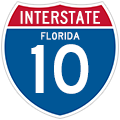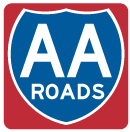Interstate 10 Florida - East


Crossing the Perdido River, I-10 east enters the Sunshine State. Concrete roadways in Escambia County were paved over with asphalt by March 2002. 06/23/01

The one-mile guide sign for Exit 5 (U.S. 90 Alternate) stands next to the Florida Welcome Center. This view looks at the original guide sign for the fist of six Pensacola area interchanges. 12/02/00

The control city of Perdido Key was added to Exit 7 signs during December of 1999 in place of Pine Forest Road. Pine Forest Road returned to guide signs for SR 297 in December 2002. 01/18/06

The previous set of guide signs posted on the Exit 7 sign bridge and original Interstate 10 concrete in its last full year of existence. While two ramps serve Pine Forest Road in the eastbound direction, westbound is afforded just one ramp departure. 06/23/01

Original concrete and the previous version of the Exit 7B guide sign for Interstate 10 east. The overpasses of Interstate 10 in Escambia County saw reconstruction during 1996 and 1997. 06/23/01

Replaced guide sign for Exits 10A/B, junction U.S. 29 on Interstate 10 eastbound. U.S. 29 (Pensacola Boulevard) was expanded from four to six lanes within the vicinity of Interstate 10 in 1998. 06/23/01

Signs for Exits 10A/B in both directions of Interstate 10 were greened out to include Pensacola Boulevard in April 2010. 12/06/03

Exit 10B loops onto U.S. 29 north to Ensley, two miles west of Interstate 110. In typical FDOT fashion, the exit number was omitted from the two-mile sign of an Interstate to Interstate junction. 01/18/06

All Interstate 110 signage was replaced in 1999. These views look at two previously used one-mile guide signs for Interstate 110 posted during the early years of the I-10-110 interchange construction project. The project began in 2003 and was originally scheduled for completion in 2006. 12/06/03

All Interstate 110 signage was replaced in 1999. These views look at two previously used one-mile guide signs for Interstate 110 posted during the early years of the I-10-110 interchange construction project. The project began in 2003 and was originally scheduled for completion in 2006. 05/23/05

A historical look at construction crews in the process of replacing the Exit 4 tab of I-110 with a mileage based Exit 12 tab. The state of Florida embarked upon an exit renumbering campaign in 2001 and 2002. Exit numbers were not altered along the 6.39 miles of Interstate 110. 02/02/02

How the one-half mile guide sign for Florida 291 (Exit 13) looked before Interstate 10/110 reconstruction began. Florida 291 constitutes a heavily traveled surface arterial between Florida 295 (Fairfield Road) and Ferry Pass. The highway rivals U.S. 29 with commercial frontage. 06/23/01

Florida 291 / Davis Highway overhead on Interstate 10 eastbound, pre-construction. Note the tree-lined buffer zone along the south side of the freeway. This overhead was installed during 1996 advising traffic merging from northbound Interstate 110 that the lane became exit-only for Florida 291 (Exit 13). This overhead debuted in 1999, replacing a substandard sign displaying "SR 291 - Exit Only". 06/23/01

The scene of the Exit 13 ramp departure pre-construction. The ramps for Florida 291 reside along the east side of Davis Highway due to close proximity of the Exit 12 interchange. 06/23/01

Looking at the Exit 12 ramp end before expansion. Former University Mall lied to the left and West Florida Regional Medical Center (now West Florida Hospital) one mile to the north. 07/17/04

FDOT Crews replaced Exit 17 guide signs for U.S. 90 to include the control point of Pace in 2004. 11/16/03

Older signage used for U.S. 90 (Exit 17) on Interstate 10 east. Note the original concrete still in use at the time. 06/23/01

Opened in 1967, the original Escambia Bay bridges carried just four lanes with partial outside shoulders. 12/06/03
Photos by AARoads
Page Updated Friday January 24, 2025.


